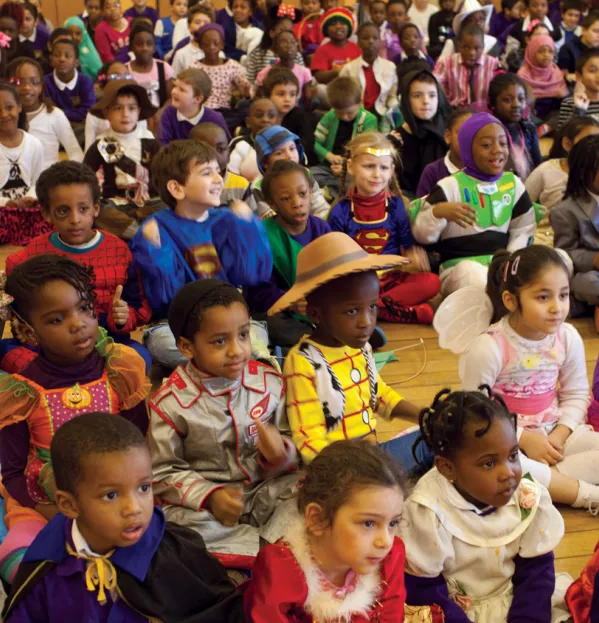Why diversity should start at story time

A few years ago, I was teaching a Year 2 class in East London. We had been working on writing stories. When it came to sharing what they had written, one boy, who had recently arrived from Nigeria, was eager to read his work to the class.
As he read out his protagonist’s name - I had suggested that children might use the names of people in their family - another boy, who was born in Britain and identified as Congolese, interrupted him.
“You can’t do that! Stories have to be about white people,” he said. This is not an isolated incident.
More than 25 years ago, Verna Wilkins founded Tamarind Press because her child believed that characters had to be white “to be in a book”. And the award-winning author Chimamanda Ngozi Adichie recalls her childhood in Nigeria where, “because all I had read were books in which characters were foreign, I had become convinced that books by their very nature had to have foreigners in them and had to be about things with which I could not personally identify”.
Many primary school children have encountered only books with white human characters. Often when they do encounter characters racialised as other than white, it is tied in with the celebration of a holiday such as Diwali, or in connection with Black History Month.
Yet it seems reasonable to wish that children see people of all backgrounds as an ordinary part of everyday literature.
If children do not encounter a rich diet of literature at school, they are being denied key knowledge about themselves and the world. If children are not taught that they can draw on first-hand experiences when they write fiction, then they are being denied key knowledge about what it means to be a writer.
We should teach and read and interact with the living cultural heritage of the young people who make up Britain today - not to the exclusion of “classic” literature, but rather as part of the process of opening up of the world of literature for children. Stories often deal with universal themes but it is the writer’s ability to capture the particularities of a story that brings it to life and makes it resonate with readers. In The Art of Fiction, Henry James calls this “solidity of specification”, adding that it is “the supreme virtue of a novel”.
Out of print
Writers of colour have been publishing in Britain for British audiences for more than 50 years now, but often these books have gone out of print, with publishers citing lack of audience.
But the audience is there, because all children are (or should be) the audience for good literature. The problem is getting those books into children’s hands, especially when the few physical book shops left in any given town often don’t stock a wide variety (if any) books by or about people of colour.
Teachers and other adults involved with children have to seek books out, often through internet-based booksellers, and the time this takes - not to mention the difficulty of evaluating a book’s appropriateness without being able to page through it - can seem like one burden too many for already-overtaxed teachers.
Many primary pupils have encountered only books with white characters
However, there are resources that can help: Letterbox Library has been providing multicultural books to schools for more than 30 years, and they allow teachers to order books “on approval”, so they have time to evaluate them. There are several blogs written by experts in the field, which offer their own suggestions for teachers who don’t know where to start.
The effort is worth it, because when kids start seeing themselves and their classmates in books, they learn that they all have a role to play - in the classroom, in books and in Britain’s literary heritage.
This role can extend children’s own writing. After reflecting on my experience with my Year 2 class, the following year, while teaching Year 5, I was emboldened to experiment. What would happen if, for just one lesson, I encouraged them to write about a character from a similar ethnic, religious and linguistic background to their own - just as I sometimes insist that they try to include a fronted adverbial, a moral dilemma or a tricolon?
Having collected a range of passages where authors describe a character, we discussed ourselves in terms of various attributes: language, family migration, physical appearance including skin and hair, religion, hobbies and clothes. Then I asked the children to write a character who was similar in some but not necessarily all of these aspects.
Composite characters
As I modelled this process for them, I realised that previously I, too, often defaulted to “traditional” English names and white characters when writing in class. Now, I tried to draw on my own experience, creating composite characters from family members and applying some of the writing techniques we’d noted in our class reading.
Then they wrote. Clearly, many of them enjoyed the lesson and many produced their best piece of writing to date.
Here’s one example by a pupil called Nabila: “Maryam Patel was a 12-year-old girl, whose parents were Indian, but she was born in Britain. She was a fairly religious person. However, Maryam thought, one does not have to wear a headscarf to be religious. She loved her red, straight hair. Her hair was as red as blood. She had decided to dye her hair as she hated her dark brown hair. She loved football and the club she supported was Liverpool. One day I’ll play for the Liverpool women, she thought.”

I want to avoid making huge claims here. However, I do sense the beginnings of an authorial voice in Nabila’s character description. Her character is not a stereotype of Muslim girls - in recognising her life experience as a valuable resource for fiction, she is developing the “solidity of specification” and avoiding what Adichie terms “the danger of the single story”. There is some genuine characterisation and insight in the paragraph rather than the short list of features that I often encounter in children’s writing.
I think this is precisely because she is using her own life as inspiration for her creativity while drawing on her reading of fiction. Her descriptive paragraph comes after a lesson looking closely at descriptions by a range of children’s authors, which is where the idea of including a protagonist’s thought, as well as a simple physical description, emerged. As well as writing a better story - richer in detail, and combining her knowledge gained from reading with knowledge gained from experience, Nabila was demonstrating an understanding that people from her background can indeed be main characters rather than minor characters.
Nabila told me that she had never written about an Indian heritage or Muslim character before. Nobody had ever told her she shouldn’t but, at the same time, nobody had ever explicitly given her permission. Subsequently, she wrote two further full stories about her character Maryam Patel. In part three, Maryam visited India.
Trust me, it was a great read.
Darren Chetty taught in inner-London primary schools for almost 20 years. He is currently completing a PhD at the UCL Institute of Education. He is a contributor to Media Diversified and The Good Immigrant, a collection of 21 essays by black, Asian and minority ethnic writers, edited by Nikesh Shukla and published by Unbound. He tweets @rapclassroom
You need a Tes subscription to read this article
Subscribe now to read this article and get other subscriber-only content:
- Unlimited access to all Tes magazine content
- Exclusive subscriber-only stories
- Award-winning email newsletters
Already a subscriber? Log in
You need a subscription to read this article
Subscribe now to read this article and get other subscriber-only content, including:
- Unlimited access to all Tes magazine content
- Exclusive subscriber-only stories
- Award-winning email newsletters